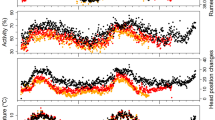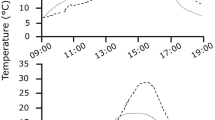Abstract
Pelage is seasonally dimorphic in the Arctic fox. During the winter, fur lengths for this species are nearly double similar values taken during the summer season. Considerable site-specific differences in fur length are noted. In general, body sites which are exposed to the environment when an Arctic fox lies in a curled position show greater fur lengths in all seasons and greater seasonal variations than body sites that are more protected during rest. Well-furred sites may tend to conserve heat during periods of inactivity, and scantily furred sites may tend to dissipate heat during periods of exercise. The growth of winter fur may compensate for the severe cold of the arctic winter. Changes in fur lengths indicate a definite pattern in spite of individual variations. During the fall months, fur lengths seem to lag behind an increasing body-to-ambient temperature gradient. Both body-to-ambient temperature gradients and fur lengths peak during December through February. From March through June, gradual environmental warming is accompanied by a decrease in average fur lengths. Thus, there appears to be a remarkable parallel between the body-to-ambient temperature gradient and the fur lengths. The growth of fur in the Arctic fox parallels annual changes in ambient temperature and photoperiod.
Similar content being viewed by others
References
BEDWELL, R. L. and WAINMAN, F. W. (1964): The effect of increased air movement on the heat production and emission of steers. J. Agr. Sci., 62: 207–214.
BLAXTER, K. L., GRAHAM, N. McC. and WAINMAN, F. W. (1959a): Environmental temperature, energy metabolism and heat regulation in sheep III— the metabolism and thermal exchanges of sheep and fleeces. J. Agr. Sci., 52: 41–49.
BLAXTER, K. L., GRAHAM, N. McC., WAINMAN, F. W. and ARMSTRONG, D. G. D. G. (1959b): Environmental temperature, energy metabolism and heat regulation in sheep II—the partition of heat losses in closely clipped sheep. J. Agr. Sci., 52: 25–40.
BLISS, L. C., COURTIN, G. M., PATTIE, D. L., ROEWE, R. R., WHITFIELD, D. W. A. and WIDDEN, P. (1973): Arctic ecosystems. In: Annual Review of Ecology and Systematics. R. F. Johnson (ed), Annual Review, Palo Alto, 359–399.
BRAESTRUP, F. W. (1941): A study of the arctic fox in Greenland — immigration, fluctuations in numbers. I. Kommission Hos. C. A. Reitzels Forlag. 97 pp.
CHESEMORE, D. L. (1970): Notes on the pelage and priming sequence of arctic foxes in northern Alaska. J. Mamm., 51: 156–159.
DAVIS, T. R. A. (1963): Acclimatization to cold in man. In: Temperature, Its Measure and Control in Science and Industry. 3: 443–457.
DURRER, J. L. and HANNON, S. P. (1961): Seasonal variation in the caloric intake of dogs living in an arctic environment. Tech. Rep. 61–33. Arctic Aeromedical Laboratory, Ft. Wainwright, Alaska.
GRAHAM, N. McC., WAINMAN, F. W., BLAXTER, K. L. and ARMSTRONG, D. G. (1959): Environmental temperature, energy metabolism and heat regulation in sheep I — energy metabolism in closely clipped sheep. J. Agr. Sci., 52: 13–24.
HART, J. S. (1956): Seasonal changes in insulation of fur. Canad. J. Zool., 34: 53–57.
HART, J. S. (1960): Energy metabolism during exposure to cold. Fed. Proc., 19: 15–19.
HEROUX, O., DEPOCAS, F. and HART, J. S. (1959): Comparison between seasonal and thermal acclimation in white rats I — metabolic and insulative changes. Canad. J. Biochem., 37: 473–478.
IRVING, L. (1964): Temperature regulation of large arctic land mammals. Fed. Proc., 23: 1198–1201.
IRVING, L. and KROG, J. (1954): Body temperature of arctic and subarctic birds and mammals. J. appl. Physiol., 6: 667–680.
MILLER, I. and FREUND, J. E. (1968): Probability and Statistics for Engineers. Prentice-Hall, Englewood Cliffs, New Jersey, 431 pp.
SCHOLANDER, P. F., WALTERS, V., HOCK, R. and IRVING, L. (1950): Body insulation of arctic and tropical mammals and birds in relation to body temperature insulation and basal metabolic rate. Biol. Bull., 99: 259–271.
SELLERS, E. A., RICHMAN, S., THOMAS, N. and YEW, S. S. (1951): Acclimatization to cold in rats: metabolic rates. Amer. J. Physiol., 167: 651–655.
UNDERWOOD, L. S. (1971): The bioenergetics of the arcticfox (Alopexlagopus L.). Ph. D. thesis. Pennsylvania State University. 85 pp.
Author information
Authors and Affiliations
Rights and permissions
About this article
Cite this article
Underwood, L.S., Reynolds, P. Photoperiod and fur lengths in the arctic fox (Alopex lagopus L.). Int J Biometeorol 24, 39–48 (1980). https://doi.org/10.1007/BF02245540
Issue Date:
DOI: https://doi.org/10.1007/BF02245540




